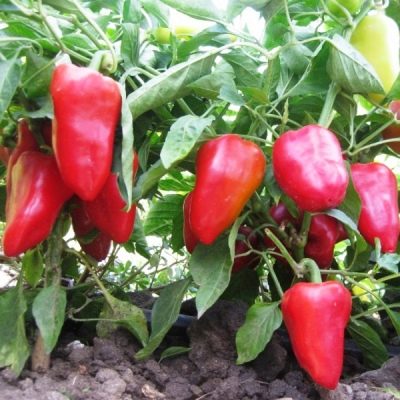
- Authors: Koroleva S.V., Anikeenko V.S., Sitnikov S.V.
- Year of approval: 2007
- Bush height, cm: 60
- Growth type: medium-sized
- Fruit shape: conical
- Fruit weight, g: 68-110
- Fruit color: greenish-white in technical ripeness, red in biological ripeness
- Ripening terms: early
- Ripening month: from the end of July
- Yield: high
Fisht sweet pepper was bred by Russian breeders more than 10 years ago and has already managed to fall in love with Russian gardeners. It is versatile, it is grown both in the open field and in protected, under film shelters. This hybrid has excellent qualities that set it apart from other pepper crops.
Breeding history
Fisht F1 is one of the first bell pepper hybrids developed in the Russian south by domestic breeders S. Koroleva, V. Anikeenko, S. Sitnikov on the basis of the Federal Rice Scientific Center, which recently celebrated its 90th anniversary. The birthplace of culture was Krasnodar (the village of Belozerny), which largely explains its name, which was assigned to it by the originators, taking as a basis the peak of the same name of the Caucasian ridge. In 2007, the hybrid variety was included in the Rosreestr and approved for cultivation in the North Caucasus region.
Description of the variety
Pepper Fisht F1 is classified by experts as a representative of the Hungarian-type line. The fruits of the culture have high marketable, excellent gastronomic qualities. The product even has medicinal properties. It is noted that pepper can have a beneficial effect on the body in cardiovascular diseases, saturates it with vitamins, and it also increases immunity to viral diseases.
Characteristics of the appearance of plants and fruits
The bush of the presented culture is a closed plant with an average height. The leaves are medium in size, painted in green tones, the leaf plate is slightly wrinkled. The arrangement of fruits on the branches is drooping. The shape of the peppers is conical, the skin is glossy. The color of the fruits in technical ripeness is greenish-white; when biological maturity is reached, they turn red.
Pepper has 3-4 nests. The weight of each pepper varies from 68 to 110 g, the walls of the fruits are 5-5.6 millimeters thick. On one plant 6-8 red fruits can ripen at the same time.
Purpose and taste
Fresh fruits already at the stage of technical ripeness have a good, even excellent taste, but especially exquisite taste indicators are noted in pickled ripe peppers. The flesh of the fruit is rather fleshy. The fresh product looks very elegant both in appetizers and in assorted dishes. Used for stuffing, baking, cooking first courses. On the basis of Fisht pepper, cooked lecho, adjika, second courses are very tasty. And also the peppers are frozen, and it is convenient to do this by putting the fruits into each other.
Ripening terms
An early ripening hybrid is referred to as early and mid-early. The ripening period is 90-105 days from the emergence of seedlings to the beginning of fruiting. Ripening dates from the end of July.
Yield
The high yield of the crop under consideration varies on average from 168 to 335 c / ha.
Growing regions
Pepper Fisht, created by Krasnodar breeders, is zoned primarily in its homeland - in the Krasnodar Territory. Favorable growing regions are the Rostov Region, the Stavropol Territory, the Republic of Crimea, the North Caucasian republics such as Chechnya, Dagestan, Ingushetia and others.

To get a large and tasty harvest of pepper, you need to take care of the seedlings in advance. When growing pepper seedlings, you need to correctly determine the sowing time, pre-sowing seed treatment, prepare the necessary container and soil.
Growing and care
The seeds of the described culture are sown in a moist and rather nutritious soil, which can be made independently from turf, compost, as well as humus and peat. The seed material is deepened by a centimeter, after which it is necessary to cover the containers with foil. Irrigation and feeding will be needed both before and after the pick.
Watering is possible only with warm liquid, by means of a spray bottle. Somewhere 7-10 days before transplanting, the grown seedlings are hardened. Seedlings are transferred to a permanent place when they are 60-75 days old.
Fisht peppers are cultivated in both open and sheltered ridges. The main thing is that there is enough light, as well as a well-fertilized soil mixture.
Bushes must be formed after the stem height reaches 17-20 centimeters. It is from this level that the first branch usually departs. It is recommended to pinch the stepsons. Further, for good development, you need to remove the crown bud. This action will help control plant growth as well as regulate fruiting.

To harvest a tasty and rich harvest of pepper, you need to comply with all the conditions of agricultural technology, and proper care begins with planting plants. Before planting pepper in open ground, it should be prepared. It is also important to take care of the seedlings and planting space in advance.




For good growth of pepper bushes and active fruiting, you need to regularly apply mineral and organic fertilizing to the soil. It is necessary not only to choose the right formulations, but also to use them at the right stage in the development of culture. The frequency of top dressing is always individual. It depends directly on the composition of the land on your site. The poorer the soil composition, the more often you will need to feed the pepper.
Disease and pest resistance
The hybrid variety Fisht has excellent immunity. The culture is especially resistant to verticillosis.

Pepper is one of the most common vegetables in home gardens. This culture is quite stable and unpretentious. However, under certain conditions, this plant can suffer from infections and harmful insects. Before treating peppers for diseases or pests, you need to find out the cause of the problem, otherwise the treatment may be ineffective.





















































































